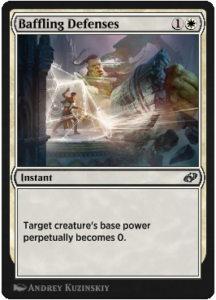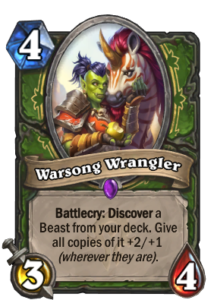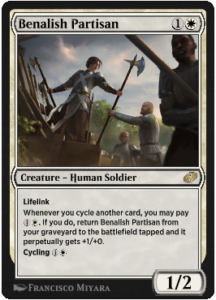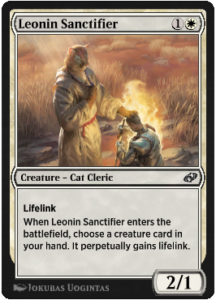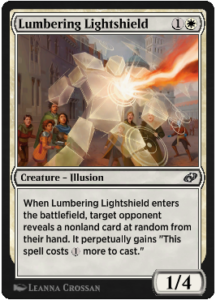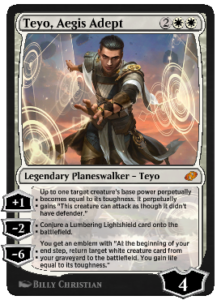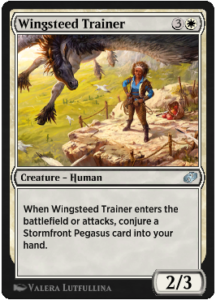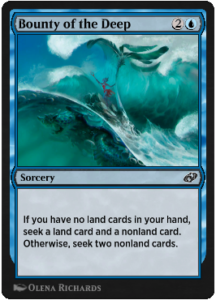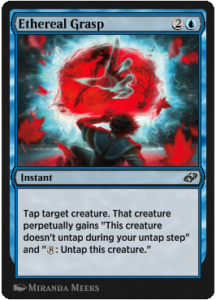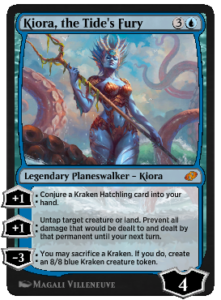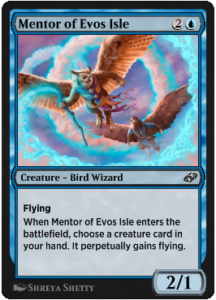After a brief delay, Jumpstart: Historic Horizons releases next week. It introduces 31 brand new Arena-only cards. While these aren’t the first cards only available on Arena, these are the first designed exclusively for Arena. That means we’ve got entirely new types of designs to evaluate, and over the next two weeks, we’ll do exactly that.
Baffling Defenses is an odd design for several reasons. For starters, perpetual debuffing has limited utility, especially in a high power format like Historic. Sure, this is stronger than an aura, since it can’t be knocked off by enchantment removal or protection, but that’s about it. It’s not a good answer to graveyard strategies, be it a Cauldron Familiar or an Ulamog, the Ceaseless Hunger.
While Baffling Defenses‘ rate is quite low, it’s also a fairly unexciting effect. Reactive removal isn’t aspirational. It’s much more exciting to buff in a permanent way, as Hearthstone’s Warsong Wrangler does (shown below).
The final and strangest reason to create Baffling Defenses (among other debuffs) is Historic Brawl. Permanent debuffs are strongest against recursive creatures and Brawl is built around a recursive Commander. It’s odd to include multiple cards which hose Commander Arena’s first digital-only foray. Sure, there’s ample challenges to adding Commander to Arena—imagine trying to coherently present four battlefields at once. But this entire vein of design is antithetical (or at least, dangerous) to Historic Brawl and has already led to two cards being banned.
Benalish Partisan seems awesome. It does the very Magic thing of being a build-around while synergizing with itself. It feels pretty close to what an existing Magic card would be, though it’s a lot cleaner than using something like experience counters. It’s balanced around both a mana cost for the reanimation ability and having only two toughness, though Lifelink helps it stall and eventually become impossible to race.
Plus, it functions within an under-served strategy that Wizards toyed with—Astral Drift in Modern Horizons 1—that never managed to achieve Astral Slide‘s prominence. This card excites me. I want to see whether it enables a new archetype and how many previously under-utilized cards may follow it to glory. Love this kind of design.
As will be a common theme, I like perpetual buffing much more than perpetual debuffing. Here, the benefit being perpetual makes sense—this simply can’t be an aura, since it secretly buffs a card in your hand. By virtue of being a proactive benefit rather than reactive interaction, it’s aspirational. You can use Leonin Sanctifier to assemble combos, be it a Brimstone Trebuchet, Demonlord Belzenlok, or a Grim Wanderer. Or you can just use it gain a bunch of life. It’s simple, but there’s a fair bit of play here.
Lumbering Lightshield is a much cleaner implementation of Elite Spellbinder at the cost of some power. Yes, it permanently taxes a recastable card (of which there aren’t many), but at the cost of not getting to see your opponent’s hand or choose what to make more expensive. This design is a fine, little hatebear. It’s a little odd for white to be playing with illusions, but Teyo’s Lightsheild already paved that ground.
I have very mixed feelings about Teyo. As a character, Teyo hearkens back to the disappointing War of the Spark story (and the dreadful War of the Spark: Forsaken followup). As a design, I’m skeptical of spending the one white Planeswalker slot on a walls-centric card. Teyo does a good job of defending himself, able to conjure up some 1/4s (or 0/3s with upside), upgrade your defensive line, or downgrade low toughness opposing creatures.
All that said, I love how his ultimate synergizes with his ability to conjure creatures, since he creates actual cards that can go to your graveyard. While I appreciate him conjuring his signature spell from War of the Spark, I kind of wish he instead conjured a version that gave Perpetual +1/+1 instead instead of a +1/+1 counter—it’d be a tiny buff that’d further show off the fun interactions possible between Conjure and Perpetual.
Author’s edit: It has been brought to my attention that Teyo does not Conjure a Teyo’s Lightshield. Instead, he Conjures a Lumbering Lightshield. I’m far less enthusiastic about about a Teyo who specializes in making 1-2 spells progressively more expensive to the point of being uncastable. While the power level doesn’t seem anywhere close as high, a Planeswalker focused on denying your opponent resources and generating 4/4s has Oko-esque vibes.
I don’t get this design. The narrative’s fine—whenever this trainer ventures out into the world, she befriends a Pegasus. But the rate is so low. By not Conjuring to the battlefield, she gives you pegasi when they’re potentially past the point of relevance. And she’s certain to die with her first attack, if not before even getting the chance.
I wish this card did something a little more wild, like Perpetually giving all your Stormfront Pegasi +1/+1 as it Conjured them. Something to aspire to, rather than be a slight twist on Falconer Adept.
This is lovely. It’s a Divination that most of the time is a bit better. It has similar function to Fathom Trawl and Abundant Harvest, but without the troublesome revealing of information or flipping of physical cards. While this does nothing novel, it’s a cleaner implementation of an existing effect, and that’s something I’m happy to see digital employ alongside more out there designs.
As with basically all JHH removal, I’m not enthusiastic. How often will it matter that this debuff is Perpetual rather than an aura? And given the low rate, how often is anyone going to play this (other than to mess with someone’s Commander in Arena)?
Unlike Teyo, I’m a fan of Kiora as a character. But while Teyo is mechanically interesting, Kiora, the Tide’s Fury feels tame, barely justifying its inclusion as a digital card. Is it really that interesting to Conjure a one mana card to hand rather than create a 0/4 token? Obviously, she’d need to be balanced accordingly, but I’m not wowed by this implementation of digital design.
As a design, she feels fine. I know that Planeswalkers are notoriously difficult to evaluate, but a -3 that upgrades a Kraken Hatchling into a kraken doesn’t excite me. I do appreciate her unrelated +1’s mixed utility of both mana acceleration and protection, though I don’t love how both of her +1s are defensive abilities.
Mentor of Evos Isle is a weaker version of Leonin Sanctifier and I have much the same praise to heap upon it. It’s proactive and aspirational rather than reactive. The rate here is low enough that it seems unlikely to see competitive play, but this enables potentially fun shenanigans.
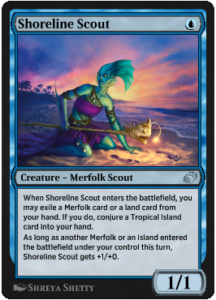
One should never discount a tribal one drop, and Shoreline Scout could well be a component of Historic Merfolk. But I can’t help but feel like this is squandering potential excitement. This Conjures one of Magic’s most iconic and expensive Legacy cards—an Alpha dual land—but it feels underwhelming. Sure, it’s powerful to upgrade a land into a Tropical Island or convert a fish into a land drop, but that feels dry, utilitarian, and Spikey when Conjuring a famous card ought to (in my mind, anyway) be a thrilling, Tammy experience as well.
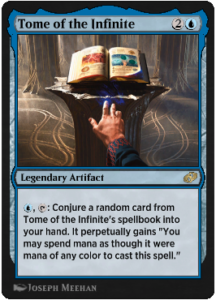
Now this is a Tammy experience. Getting a random spell from among ten, some of which are iconic, others less so, feels like the kind of card we’ll one day see a Momir Basic-esque format based around.
The array of spells is interesting, since they’re so diverse in effect that it feels nigh-impossible to construct a deck able to profitably employ each option. I like how Discover-style effects lead to improvisation, like giving a control deck an opportunity to make use of an Assault Strobe or Giant Growth they’d never put in their decks.
There’s an interesting question about the color pie, since this technically gives monoblue decks access to Lightning Bolt, Swords to Plowshares, and Fog—heck, the vast majority of effects are unavailable to blue. I think this sets a dangerous precedent akin to Aetherworks Marvel and Collected Company, where an effect becomes permissible because of variance. We’ll see where this leads, but I’m in the camp of colors never being able to do out-of-color effects, rather than having access to weaker (and in this case, unpredictable) versions.
Lastly, this card feels weird in the wake of Garth One-Eye. Yes, this works much more cleanly digitally (both the random selection and not having to cast it immediately), but Garth being a rainbow card unambiguously provides access to all colors abilities. True it’s at the cost of being nigh-uncastable. But I’d be more excited about Tome of the Infinite if we hadn’t just seen a similar effect two months ago.
And that feels like a good place to leave things today. Next week, we’ll cap things off with the remaining cards before moving into Innistrad spoiler season.
Zachary Barash is a New York City-based game designer and the commissioner of Team Draft League. He designs for Kingdom Death: Monster, has a Game Design MFA from the NYU Game Center, and does freelance game design. When the stars align, he streams Magic (but the stars align way less often than he’d like).

